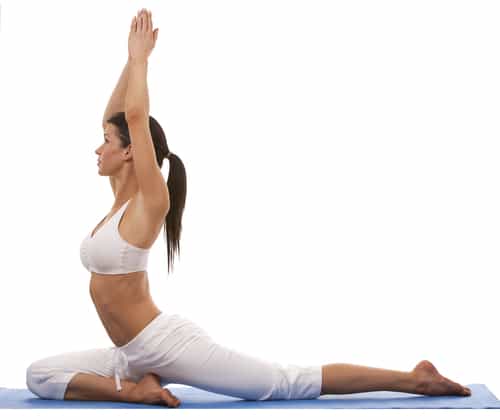
What is Flexibility?
Flexibility refers to how much joint range of motion you have. Bones are connected to each other by ligaments. It’s ligaments that help stabilize a joint but also give it a certain amount of “give” or flexibility. Ligaments are made up of connective tissue, mainly bundles of collagen, and collagen has viscoelastic properties, meaning it’s both “viscous” and “elastic.” A completely viscous tissue changes shape when you press on it and permanently maintains that shape. Elastic tissue, on the other hand, snaps back once the force acting on it is removed. Ideally, a tissue has both, which connective tissue does. This allows ligaments to offer support but still allows a certain degree of flexibility due to their elastic properties.
Some People Are Born More Flexible
Some people who are naturally more flexible because they’re born with connective tissue that has more elasticity. Actually, it’s a bit more complicated than that since a person’s range of motion is also influenced by the musculoskeletal system, the overlying skin, and input from nerve pathways, but connective tissue elasticity is an important factor. As it turns out, some people have more elastic tissue in their ligaments and tendons genetically. That doesn’t mean you can’t change how flexible you are through flexibility training.
How Age Affects Flexibility
It should come as no surprise that joint flexibility decreases with age. Why does this happen? Mostly because connective tissues lose some of their tissue elasticity over time. Tendons that attach muscles to bones also become more rigid. In addition, joint collagen changes structurally – crosslinks form and the collagen becomes firmer due to calcification. This causes ligaments and tendons to shorten, reducing their range of motion. The good news? Flexibility training can you maintain flexibility as you age.
Women Are More Flexible Than Men
Women have an advantage when it comes to flexibility. Could that be why you don’t see a lot of men doing yoga? Why women are more flexible than men still isn’t clear but is likely due to differences in joint structure and connective tissue composition.
Temperature
Warm joints are more flexible than cold ones. That’s why it’s important to warm-up before a workout. It raises core body temperature and increases joint flexibility. If you’re exercising in the cold, give yourself more time to warm up.
Wanna work out when you’re the most flexible? Flexibility usually peaks in the late afternoon as core body temperature rises. This is why your risk for injury is lower when you exercise later in the day.
Type of Joint
Some joints have no flexibility because they aren’t meant to be flexible. These are called synarthrodial joints. An example are those in your skull. The type of joints that allow the most flexibility are called diarthrodial joints. These are the ones that respond to flexibility training. Here’s a fact that may surprise you. It’s possible to be flexible in some joints but relatively inflexible in others. For example, some people are more flexible in their upper than their lower body or vice versa.
Activity Level
Sedentary people lose some of their joint flexibility. There’s even evidence that inactivity causes chemical changes in the joints that reduces flexibility. The take-home message? Don’t stop working out.
Can You Be Too Flexible?
Having a certain degree of flexibility can reduce your risk for injury and help improve your posture – but you can be too flexible. If your ligaments have too much “give” or are overstretched, they aren’t able to stabilize the joint and you’ll be at increased risk for injury. One study showed children who are “hypermobile” in their joints are at increased risk for musculoskeletal pain later on. You can also overstretch a ligament and cause it to become inflamed.
One way to increase joint stability due to ligaments that are too flexible is to strengthen the muscles that support the underlying joints through strength training. Muscles need a certain degree of flexibility so they don’t shorten and contract and reduce your range of motion. That’s why it’s important to balance strength training with flexibility training.
Increasing Flexibility
Static stretching helps to increase flexibility but it’s best to do it at the end of a workout when your muscles are warm – and hold the stretch for 15 to 20 seconds. Never stretch a muscle to the point of pain or discomfort. Avoid ballistic stretching – no bouncing or bobbing. Ballistic stretching offers no benefits and may be harmful. Stretch all the major muscle groups and the opposing ones but spend a little more time on areas where you’re less flexible.
Don’t skimp on stretching – too many people do. Even ten minutes of static stretching a day after you’ve completed a workout has flexibility benefits. Take a break at work, get up and walk around and do some gentle stretching. It’ll help loosen up tight muscles and joints and increase circulation. Sitting too long is a risk factor for health problems like type 2 diabetes and heart disease. Need I say more?
The Bottom Line?
Genetics and age are a factor when it comes to how flexible you are – but you can improve your flexibility at any age with gentle stretching exercises. If you strength train, its’ important strike a balance between strength and flexibility. Don’t neglect the stretching portion of your workout.
References:
Flexibility Training by Len Kravitz, Ph.D. and Vivian H. Heyward, Ph.D.
IDEA Health and Fitness. “Stretching–A Research Retrospective”
Arthritis Rheum. 2013 Apr;65(4):1107-15. doi: 10.1002/art.37836.
Related Articles By Cathe:
Does Resistance Training Reduce Flexibility?
Flexibility and Fitness: Can You Be Too Flexible?
Does Foam Rolling Really Improve Flexibility?
How Flexibility Changes with Age
Does Stretching Really Increase Flexibility?
Related Cathe Friedrich Workout DVDs:

